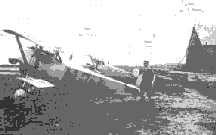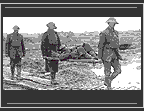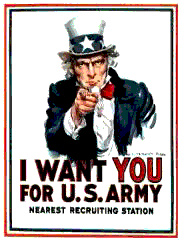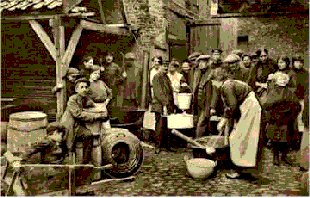World War I WebQuest
"The War To End All Wars"
if your computer and browser are equipped for
sound,
start here
[NOTE: MY APOLOGIES - I HAVE NOT HAD A CHANCE TO UPDATE THESE
PAGES YET.
THEY WILL BE UPDATED DURING WINTER BREAK [2004].]
The WWI WebQuest is designed to help you answer the essential
question "What is it like to be in a conflict". You will use
primary sources to explore the experience of different
participant's roles in World War I and what it may have been like to
have been in 'their shoes'. As you examine the role and perspective
of each of these participants, you will:
- [Stage 1]
- Synthesize an understanding of how war affected your
particular participant's viewpoint and experience of this
war.
-
- [Stage 2]:
- Share this understanding with a larger group comprised of
all the different types of participants, in order to be able to
write an analysis and response to the essential question.
-
- [Stage 3]:
- Provide a group presentation, to the rest of the class, to
help all of us understand "What is it like to be in a
conflict".
-
In order to begin the World War I WebQuest,
click on the image of the participant you are assigned to study.
Once at that page, follow the instructions listed there as
you explore the three-sets of primary sources.
Remember, you are exploring these pages in order to answer the
question "What is it like to be a participant in a
conflict".
A teacher's
guide
[Unit of Practice] and the
student worksheets can be found at
http://www.sonic.net/bantam1/guide_wq.html

soldier's experience
|

pilot's experience
|

nurse/medic's experience
|

leader/officer's experience
|

experience of civilians in the war
zone
|

journalist's experience
|

experience from the homefront
|
Picture Bibliography:
- soldier.gif
- Plotke, Jane et. al. "WWI images, plate 34." The World War I
Document Archive. Last Updated: January 11, 1999.. The Great War
Primary Document Archive, Inc.. December 28, 1999.
<http://raven.cc.ukans.edu/~kansite/ww_one/docs/51st/images/plate34.jpg>.
-
- medic2.gif
- Lee, Stuart and Groves, Paul. Virtual Seminars for Teaching
Literature. October 1998. the Oxford University Computing Services
Home Page . 1 January 2000.
<http://info.ox.ac.uk/jtap/>.
-
- pilot.gif
- Cosmas, G.A (ed.). "Marine Flyer in France." The World War I
Document Archive. 29 December 1996. Great War Primary Documents
Archive, Inc. 28 December 1999.
<http://raven.cc.ukans.edu/~kansite/ww_one/marines/cunning/flyer.html>.
-
- journalist.gif
- Cosmas, G.A (ed.). "World War I: Introduction." From War to
Normalcy: An Introduction to the Nation's Forum Collection . 19
October 1998. The American Memory: Library of Congress. 28
December 1999.
<http://memory.loc.gov/ammem/nfexwwin.html>.
-
- leader.gif
- Wever, Bill et. al.. "World War I - Burt County, NE.." NE GEN
Web Project. 8 November 1997. US GEN Web Project. 28 December
1999.
<http://www.rootsweb.com/~neburt/ww1/burtww1.html>.
-
- civilian.gif
- Wielinga, M.P.. "Civilian Refugees 1914-1918." Refugees in the
Netherlands during the First World War. 14 October 1999. [last
viewed: 28 December 1999].
<http://war1418.com/refugees/english/vluchtelingen/pag04.htm>.
-
- homefront.gif
- Doll, M.F.V.. "The Poster War - For Home and Country." The
Poster War: Allied Propaganda Art of the First World War. 21 March
1999. The Provincial Museum of Alberta. 28 December 1999.
<http://www.pma.edmonton.ab.ca/vexhibit/warpost/english/post27.htm>.
-
- background bluebaca.gif
- from the Canadian poster: Bonds - "Back Him Up!"
located at <http://www.worldwar1.com/post008.htm >
The Provincial Museum of Alberta
<http://www.pma.edmonton.ab.ca/vexhibit/warpost/english/exhibit.htm>
|
Send questions or feedback to Barry
Sovel
|
return to top of page
|
The World War 1 WebQuest can now also be
found at
- the Apple
Learning Exchange
[http://ali.apple.com/ali/]. The ALI is an online
community where educators can share, learn and
communicate. It provides detailed ideas and examples for
teaching with technology that can help you integrate new
media into your work. Apple collaborated with the
National Science Foundation and the New American Schools
Development Corporation to create a structured curriculum
framework for sharing lessons, and named it Units of
Practice (UOP). It provides a 'warehouse' of Units Of
Practice that have been reviewed, approved and rated.
Each UOP is developed by an experienced teacher, and
exemplifies an approach to integrating technology into
the teaching and learning process. Each unit has detailed
state and national standards correlated to it. The WW1
WebQuest is listed under UOP #2650.
- the SCORE
History/Social Science site
[http://score.rims.k12.ca.us/]. The 'Schools of
California Online Resources for Education' website was
begun as a program of the Curriculum and Instructional
Steering Committee of the California County
Superintendent's Education Services Association and is
now funded and managed through the California Technology
Assistance Project. The H-SS resources listed here have
been selected and evaluated by a team of educators from
across California. These particular sites were chosen for
their accuracy, grade appropriateness, and richness. The
WW1 WebQuest may be found in the grade 10 and
grade 11 section, under Activities for World War I units
of study.
- the WebQuest
Page [http://webquest.sdsu.edu/index.html].
This site is hosted by the Educational Technology
Department at San Diego State University, and is designed
to serve as a resource to those who are using the
WebQuest model to teach with the web. The model was
developed in early 1995 at San Diego State University by
Bernie Dodge with Tom March, and was outlined then in
Some Thoughts About WebQuests. The WW1 WebQuest
may be found in the examples section, under the column:
grades 9 - 12 and the row: Social Studies.
|
last updated 16 December, 2005
For more information
about Barry Sovel







